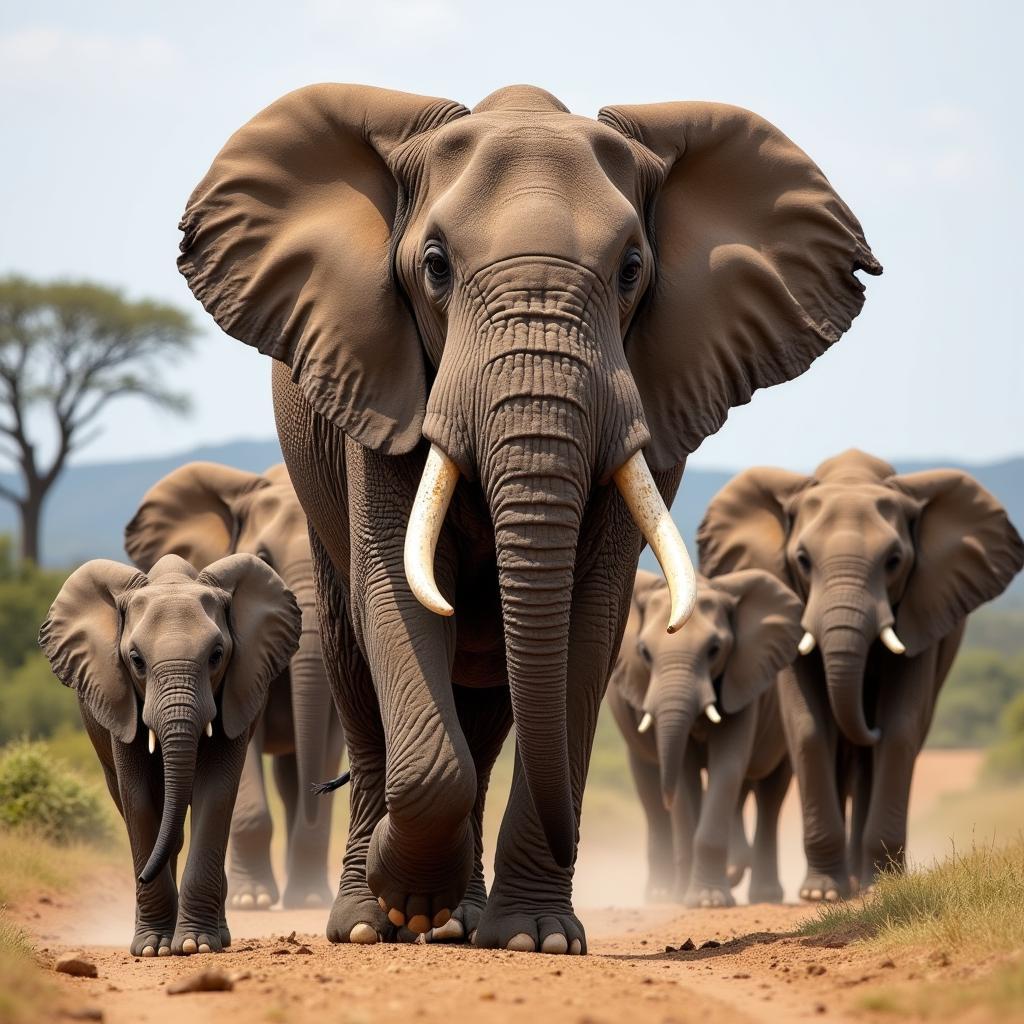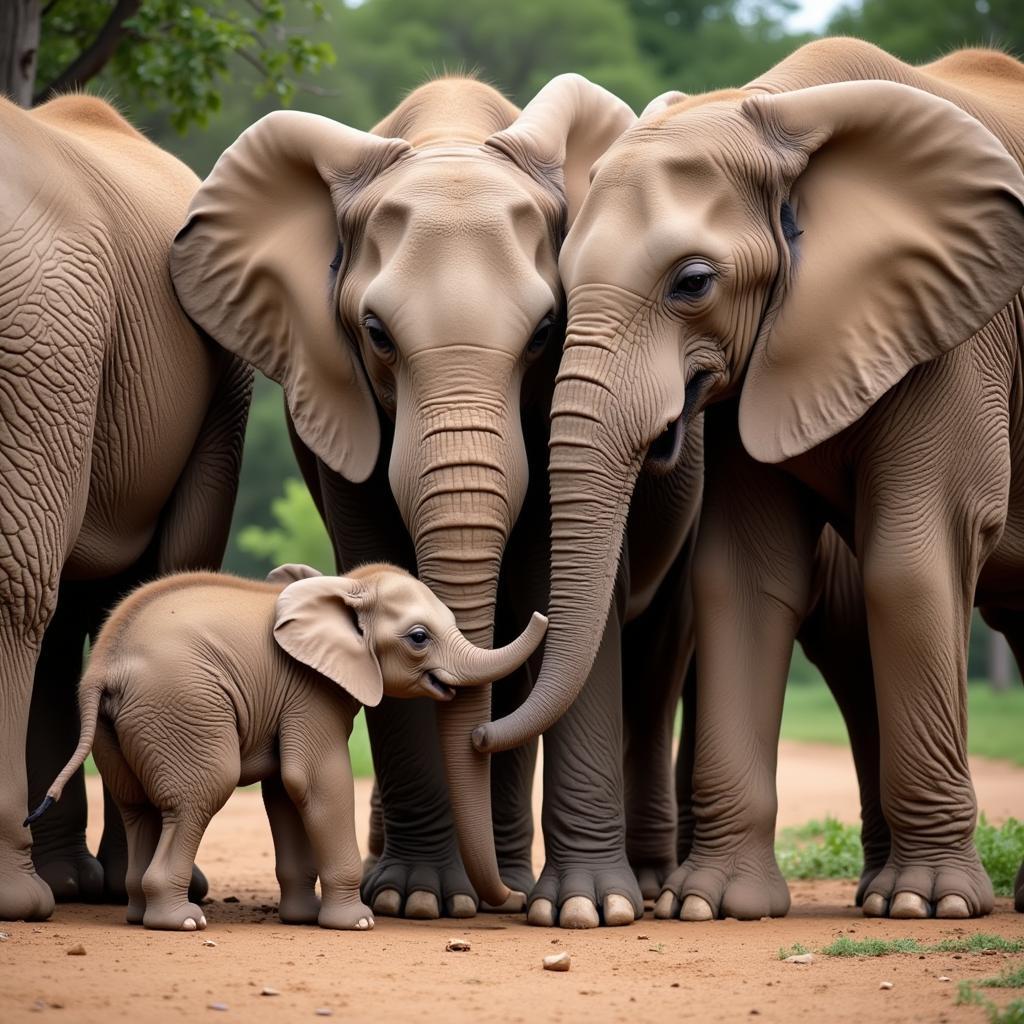The African Bush Elephant Family: A Deep Dive into Their Social Dynamics
The African Bush Elephant Family is a matriarchal society, revolving around the wisdom and experience of the oldest female. These magnificent creatures, the largest land animals on Earth, exhibit complex social structures and behaviors that are essential for their survival in the harsh African savanna. Their tight-knit family units demonstrate remarkable cooperation, communication, and emotional depth. Let’s delve into the intricate world of the African bush elephant family.
Understanding the Matriarchal Structure of the African Bush Elephant Family
The heart of the African bush elephant family is the matriarch, typically the oldest and most experienced female. She leads the family group, making crucial decisions regarding foraging, migration, and protection. Her knowledge of water sources, food locations, and migratory routes is vital, particularly during periods of drought or resource scarcity. This matriarchal structure ensures the survival of the family unit by providing stability and guidance based on generations of accumulated knowledge. You can explore more about the length of these creatures by visiting the African bush elephant length.
The family unit, also known as a herd, usually consists of related females and their young offspring. Males leave the family unit upon reaching adolescence, around the age of 12-15 years old, and live solitary lives or form small bachelor groups. This ensures genetic diversity and reduces competition for resources within the family unit. However, they still maintain contact with their natal family, occasionally rejoining for short periods.
 African Bush Elephant Family: Matriarch Leading Herd
African Bush Elephant Family: Matriarch Leading Herd
Communication within the African Bush Elephant Family: A Symphony of Sounds and Signals
African bush elephants communicate through a variety of vocalizations, including rumbles, trumpets, and roars, each carrying a specific meaning. These sounds can travel for miles across the open savanna, enabling elephants to maintain contact with distant family members. Beyond vocalizations, they employ a rich repertoire of nonverbal cues, such as ear flapping, trunk movements, and postural changes, to convey subtle messages within the family group. For instance, a raised trunk can signal a warning of danger, while gentle touches with the trunk reinforce social bonds and offer comfort.
These intricate communication methods facilitate coordination within the family, allowing them to cooperate in foraging, defense against predators, and caring for young. Check out amazing photos of African bush elephants and learn more about their family structure.
Raising the Young: A Shared Responsibility
Raising calves is a communal effort within the African bush elephant family. All the females in the herd contribute to the care of the young, providing protection, guidance, and essential life skills. This allomothering behavior allows young elephants to learn from multiple individuals and develop strong social bonds within the family unit. Calves remain dependent on their mothers for several years, relying on them for nourishment and protection. However, other females in the herd also play a vital role, offering support and guidance to the young as they grow and learn.
The shared responsibility of calf rearing strengthens the social fabric of the family unit and increases the chances of survival for the young. You can find more information on the African forest elephant wiki. Thinking about an African Safari? Check out this great resource on African safari wildlife park.
 African Bush Elephant Family: Allomothering a Calf
African Bush Elephant Family: Allomothering a Calf
The Importance of Protecting African Bush Elephant Families
The complex social structure of the African bush elephant family is vital for their survival and plays a crucial role in maintaining the balance of the African ecosystem. However, these magnificent creatures face numerous threats, including habitat loss, poaching, and human-wildlife conflict. Protecting African bush elephant families requires a multifaceted approach, including conservation efforts, anti-poaching initiatives, and community engagement. Learn about another fascinating African mammal, the African flying fox.
“The intricate social dynamics of elephant families are a testament to their intelligence and adaptability,” says Dr. Anita Kendi, a leading elephant researcher. “Protecting these families is essential not only for their survival but also for the health of the African ecosystem.”
Another expert, Dr. Joseph Mwangi, adds, “By understanding the complex social structures of African bush elephants, we can develop more effective conservation strategies to protect these magnificent creatures for generations to come.”
Conclusion: The Future of the African Bush Elephant Family
The African bush elephant family is a remarkable example of the intricate social structures and behaviors that animals develop for survival. Understanding and protecting these families is crucial for preserving these majestic creatures and maintaining the balance of the African ecosystem. We must continue to support conservation efforts and work together to ensure that the African bush elephant family thrives for generations to come.
FAQ
-
What is the social structure of an African bush elephant family?
- African bush elephant families are matriarchal, led by the oldest female.
-
How do African bush elephants communicate?
- They communicate through vocalizations like rumbles and trumpets, and nonverbal cues like trunk movements.
-
What is allomothering?
- Allomothering is the shared responsibility of raising young within the herd.
-
Why is protecting African bush elephant families important?
- Protecting them is crucial for their survival and the health of the African ecosystem.
-
What are the main threats to African bush elephants?
- Main threats include habitat loss, poaching, and human-wildlife conflict.
Need assistance? Contact us 24/7: Phone: +255768904061, Email: [email protected] or visit us at Mbarali DC Mawindi, Kangaga, Tanzania.
